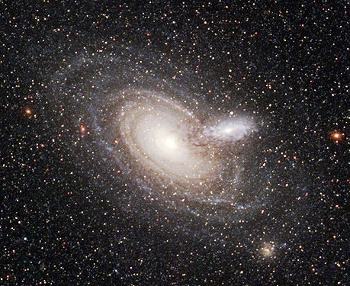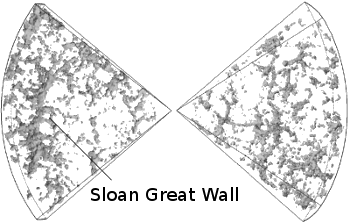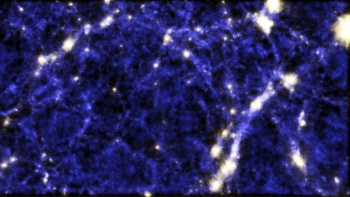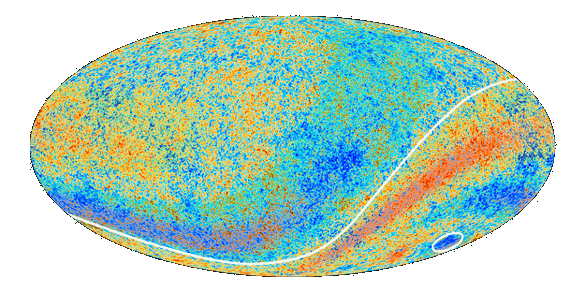Our Lumpy Universe
June 6, 2014
Children of
my generation were faced with quite a few inconveniences associated with growing up in the
1950s. Aside from having to walk
miles to
school, both ways uphill, in the
snow, and working our
math homework problems with
chalk on the back of a
coal shovel, we had lumpy
pancakes.
Food processors weren't
consumer items until well into the
1970s, but
blenders were available long before then. However, when a
newlywed's gift blender broke, it was seldom replaced, leading to the poignant
First World tragedy of lumpy pancakes.
Because of
atomic and
molecular forces, things in
nature, such as the
ingredients in pancake
batter, tend to agglomerate and are seldom
homogeneous.
Gravitational forces have that same affect in large scale structures such as our
Milky Way Galaxy. When distance measurements of
galaxies using
cosmological redshift became routine in 1989,
Margaret Geller and
John Huchra of the
Harvard–Smithsonian Center for Astrophysics discovered the first large-scale structure of the
universe.[1]

A Hubble Space Telescope. image of a pair of spiral galaxies, known as 2MASX J00482185-2507365.
(Image: NASA, ESA, and The Hubble Heritage Team (STScI/AURA), via Wikimedia Commons.)
This structure, known as the
Great Wall (more properly, the CfA2 Great Wall, named after the Center for Astrophysics, which was responsible for both the
redshift survey and the analysis), is a 500 million
light-year's wide shell of galaxies just 16 million light years thick about 200 million light-years distant from
Earth. The extent of this shell, which may be the boundary of a giant "bubble," might be larger, but our own galaxy prevents further observations.[1]
A much larger wall, the
Sloan Great Wall, named after the
Sloan Digital Sky Survey, was discovered in 2003. This wall was observed to extend 1.38 billion light-years, which is nearly three times larger than the CfA2 Great Wall. For comparison, the
diameter of the
observable universe is about 93 billion light-years.

A representation of the 2dF Galaxy Redshift Survey, showing the Sloan Great Wall.
(Modified Wikimedia Commons image by Willem Schaap.)
Nor is the Sloan Great Wall the last wall found. The farther we look, the more walls we find, the last being the
Hercules–Corona Borealis Great Wall, measuring more than ten billion light-years across, or more than 10% of the diameter of the observable universe. The discovery was made by mapping
gamma ray bursts.
Data such as these suggest that the universe is far from homogeneous, and it consists, instead, of immense
voids with galaxies defining their boundaries. It's as if the universe is actually a
foam, and the galaxies are aligned as a "cosmic web." It's conjectured that the
matter we see is aligned with a superstructure of
dark matter that gravitationally attracts the normal matter. Simulations show that the voids might contain faint filaments of galaxies (see figure).[2-3]

A simulation showing faint filaments of galaxies within a cosmic void.
(International Centre for Radio Astronomy Research (ICRAR) image by Cunnama, Power, Newton and Cui)[3)]
Do such inhomogeneities average out when we get to the scale of the entire universe? Analysis of the
cosmic microwave background radiation (CMBR) indicates that the universe as a whole might be
anisotropic, divided in half by a
poetically named "Axis of Evil."[4-6] The evil, if it scales with the degree of anisotropy, is actually quite small. The
temperature variation found in the CMBR is just a few millionths of a degree out of 2.73
kelvin.
This anisotropy might be connected with something in the early universe, but there are other possibilities. It might be caused by an object between us and the CMBR
photons, and this possibility is buttressed by the fact that the "Axis of Evil" is closely aligned with the
ecliptic, the
plane of
planetary orbits in the
Solar System (see figure).

Anomalies in the Cosmic Microwave Background Radiation, as detected by the Planck spacecraft. There is slightly higher average temperatures (red) in the southern ecliptic hemisphere and slightly lower average temperatures (blue) in the northern ecliptic hemisphere. The line marks the ecliptic, which is closely associated with the "Axis of Evil." A surprisingly cold patch is circled. (ESA and the Planck Collaboration image, used with permission.)
It might also be that we are seeing
random fluctuations in the observable Universe, which is a small part of the entire universe.[6] You will see variation by looking too closely at anything.
References:
- Margaret J. Geller and John P. Huchra, "Mapping the Universe," Science, vol. 246, no. 4932 (November 17, 1989), pp. 897-903.
- E. Tempel, R. S. Stoica, V. J. Martínez, L. J. Liivamägi, G. Castellan and E. Saar, "Detecting filamentary pattern in the cosmic web: a catalogue of filaments for the SDSS," MNRAS, vol. 438, no. 4 (March 11, 2014), pp. 3465-3482.
- These aren't the voids you're looking for, International Centre for Radio Astronomy Research Press Release, March 10, 2014.
- Kate Land and Joäo Magueijo, "Examination of Evidence for a Preferred Axis in the Cosmic Radiation Anisotropy," Phys. Rev. Lett., vol. 95, no. 7 (August 11, 2005), Document No. 071301 [4 pages].
- Kate Land and Joao Magueijo, "The axis of evil," arXiv Preprint Server, February 22, 2005.
- Matthew Francis, "Is the lopsided Universe telling us we need new theories?" Arstechnica, March 10, 2014.
- Craig J Copi, Multipole Vectors Web Site, Case Western-Reserve University.
Permanent Link to this article
Linked Keywords: Child; children; baby boomer; 1950s; mile; school; snow; mathematics; math; homework problem; chalk; coal; shovel; pancake; food processor; consumer; 1970s; blender; newlywed; First World; tragedy; atomic; van der Waals force; molecular force; nature; ingredient; batter; homogeneity; homogeneous; Newton's law of universal gravitation; gravitational force; Milky Way Galaxy; galaxy; cosmological redshift; Margaret Geller; John Huchra; Harvard–Smithsonian Center for Astrophysics; universe; Hubble Space Telescope; spiral galaxy; 2MASX J00482185-2507365; NASA; European Space Agency; ESA; The Hubble Heritage Team (STScI/AURA); Wikimedia Commons; Great Wall; CfA Redshift Survey; light-year; Earth; Sloan Great Wall; Sloan Digital Sky Survey; diameter; observable universe; 2dF Galaxy Redshift Survey; Willem Schaap; Hercules–Corona Borealis Great Wall; gamma ray burst; data; void; foam; matter; dark matter; International Centre for Radio Astronomy Research (ICRAR); cosmic microwave background radiation; anisotropy; anisotropic; poetry; poetically; temperature; kelvin; photon; ecliptic; plane; planetary orbit; Solar System; Planck spacecraft; Planck Collaboration; random.